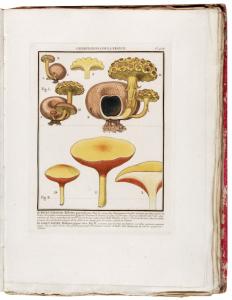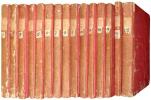Herbier de la France, ou Collection complette des Plantes Indigènes de ce Royaume; avec leurs détails anatomiques, leurs propriétés, et leurs usages en Médecine.
Eur 10,000 / USD 11,700
The price shown on each item does not include V.A.T (Value Added Tax). As a result of the recent EU legislation we are required to charge our EU customers the percentage of V.A.T. charged by the customer’s country of residence, unless they possess a V.A.T. registration number. Postage Additional.
Paris, chez l'Auteur, Didot Jeune..., 1780-(1793). 15 volumes. Folio (345 x 255mm). With 1 colour-printed frontispiece and 602 colour-printed engraved plates, 4 engraved plates (2 plates of 'Observations microscopiques' of which 1 coloured and 2 plates 'Tableaux des Genres'), and 12 engraved tables 'années 1-12'. Contemporary pink boards.
one of the most interesting colour-printed natural history works
An uncut copy. As usual it does not contain the second volume of the text of the 'Histoire des Champignons de la France'. The second part of this volume was published posthumously by Ventenant in 1812 and was destroyed by fire soon after printing and is found in only a few copies.
The present work is one of the most interesting colour-printed natural history works. The fine delicate plates are of a great scientific exactness, all by Bulliard who drew, engraved, and printed the plates himself. The colour-printing without retouching by hand, is in the Le Blon-Gauthier method, using a separate plate for each colour. A technique rarely employed for botanical books. "Bulliard was his own printer. He mixed colored inks with great delicacy and, in general, accuracy, and inked his tint plates with minute attention to detail. Some of his tintings seems to have relied on the additional effect of a rich ink tone to give greater local 'solidity'. The three tint plates were overprinted on the 'key' plate with hair's-breadth accuracy, and evidence of his method of obtaining such precise positioning, or register, can be seen in pin holes at upper right and lower left corners of the line frame. The final effect is delicate, pleasing and botanically accurate, and the whole collection has a unique quietly individual flavor. The degree of craftmanship necessary to create these prints is only apparent when one studies them in close detail' (Printing in the service of Botany, 39).
The 'Herbier de la France' is composed as follows:
Herbier de la France. Première division: Histoire des plantes vénéneuses et suspectes de la France. Paris 1784. pp. (4), x, 177, (1).
Herbier de la France seconde division: Histoire des champignons de France, Tome premier. Paris 1791. pp. (2), xvi, 368, ix.
Our copy contains plates 601 and 602 (loosely inserted at the end), missing in most copies. Pritzel mentions 600 as a total and says: 'les planches 601 et 602 manquent habituellement' and according to Dr W. Junk they might have been destroyed during the revolution. Raspail in 1840 republished these 2 plates.
Of the 600 plates 382 show fungi.
Provenance: Bookplate of Dr. J.R. Chapuis.
Great Flower Books, p. 52; Nissen BBI, 296; Dunthorne 70; Stafleu & Cowan 905-912; Junk, Rara p. 176; Volbracht 300.













